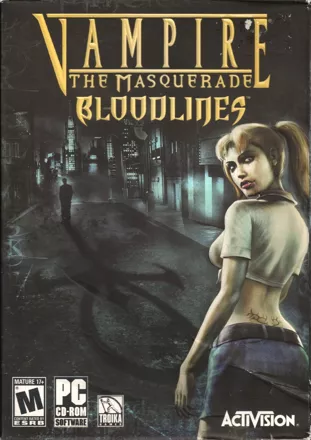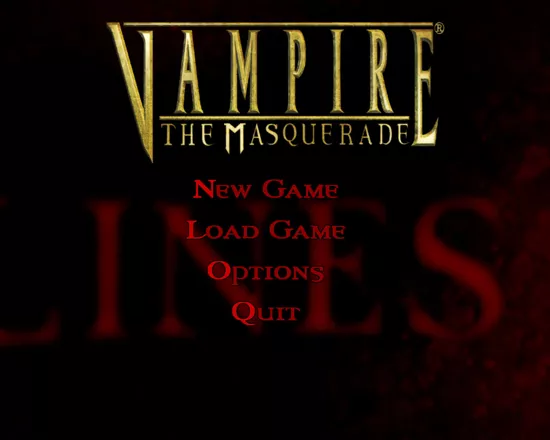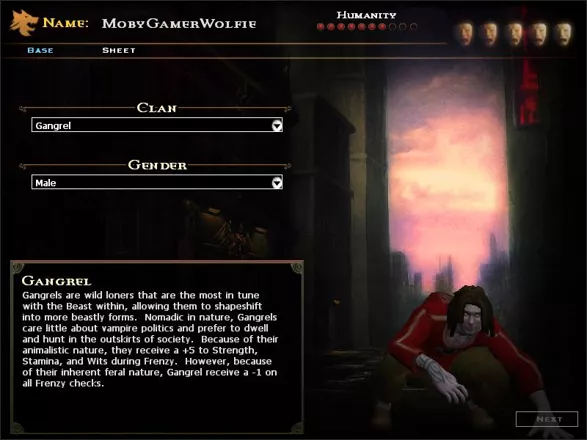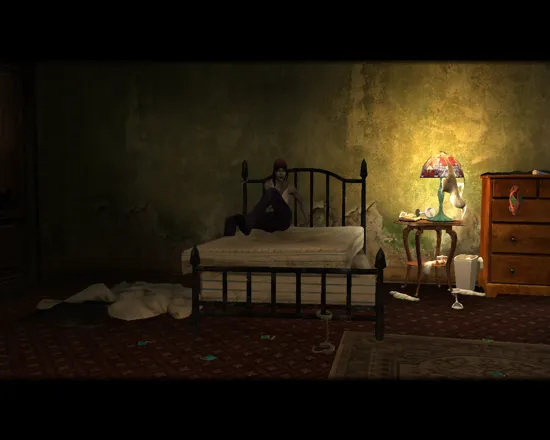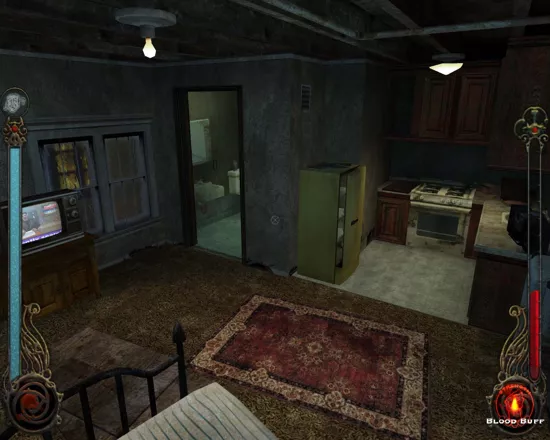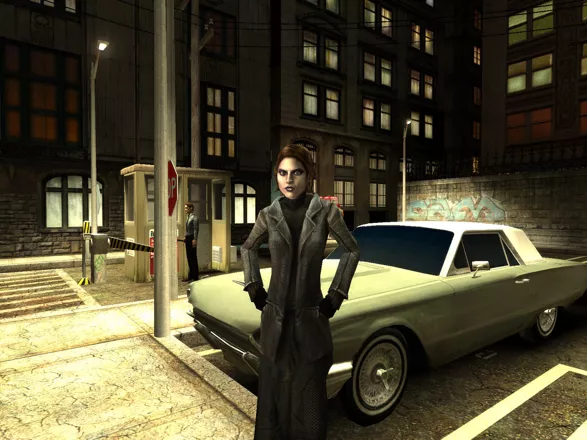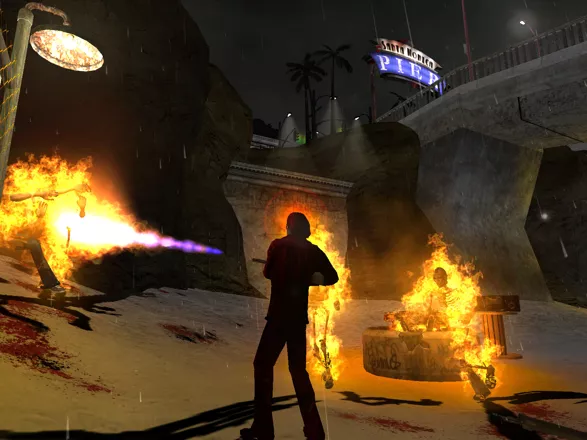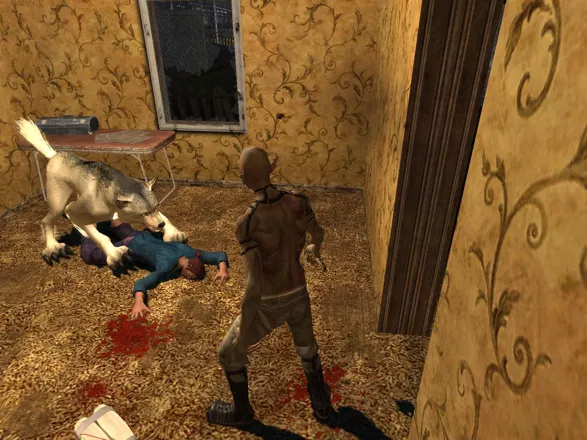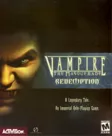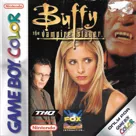Vampire: The Masquerade - Bloodlines
Description official descriptions
One morning, a seemingly ordinary inhabitant of modern-day Los Angeles wakes up and discovers that he (or she) is dead. Well, not exactly dead, but turned into a vampire - "sired", as the vampires themselves call it. Before the protagonist is able to reflect upon this new and unexpected form of existence, he is taken to a courtroom, where he gets acquainted with the Camarilla - an organization that preserves order among vampires. Apparently, the protagonist's sire turned him into a vampire without permission, so Prince LaCroix, the head of the Los Angeles Camarilla branch, decides to execute both. The hero's short vampire life would have come to an abrupt end if a mysterious person hadn't stepped in and convinced the Prince to spare it. The Prince takes responsibility for the protagonist from now on and decides to test his abilities, sending him to Santa Monica. Before long the new vampire becomes involved in a net of intrigues between powerful organizations and vampire clans and must choose his own place in this terrifying new world.
Vampire: The Masquerade - Bloodlines is based on the pen-and-paper RPG Vampire: The Masquerade. In the beginning, the player creates the protagonist, choosing between vampire clans, each with its own unique abilities and disciplines: Brujah vampires are suitable for melee fighting, Tremeres can cast spells, etc. In some cases the choice of a clan greatly changes subsequent gameplay: for example, Malkavians are insane and will therefore have completely different surreal dialogue choices; Nosferatu are so ugly that they can't pass for humans and will have to travel through underground paths throughout the game, etc.
The main character gains experience points only for completing quests, not for killing enemies. Many side quests are available during the course of the game. Experience points can be manually allocated to raise the protagonist's attributes, as well as improve various vampire feats. The player can make the main character stronger in combat, proficient in computer hacking or stealth, more powerful in vampire disciplines, more attractive, more intimidating, and so on.
Combat in the game is action-based. The protagonist can fight unarmed, use melee weapons and firearms, or employ special vampire abilities. Melee combat is viewed from the third-person perspective, but the view switches to first-person if the main character is using a gun. Blood is used to activate the vampire disciplines, working similarly to magic points in other games. It can be replenished by feeding on certain types of enemies.
The protagonist can also feed on innocent humans, though there are repercussions for that. The rules of the Masquerade forbid vampires to reveal their true nature to humans. Openly feeding on humans violates the Masquerade; five Masquerade violations lead to an instant Game Over. Feeding on humans with no witnesses present does not violate the Masquerade; however, killing an innocent human in the process alerts the authorities and causes the player character to lose some of his or her humanity. Losing too much humanity results in the protagonist becoming more and more susceptible to frenzy, eventually turning into an uncontrolled beast.
Many quests can be completed in different ways - brute force, stealth, diplomacy, intimidation, etc., depending on the preferred style of play and the main character's attributes. The player will also have to decide which faction the protagonist should side with throughout the game. Eventually, the player's choices will branch the storyline, leading it to one of the five possible endings.
Spellings
- 吸血鬼:避世之血族 - Chinese spelling (simplified)
Groups +
- 3D Engine: Source
- Gameplay feature: Character development - Skill distribution
- Gameplay feature: House ownership
- Gameplay feature: Multiple endings
- Green Pepper releases
- Middleware: Bink Video
- Physics Engine: Havok
- Protagonist: Female (option)
- Protagonist: Vampire
- Setting: City - Los Angeles
- Setting: Hotel
- Software Pyramide releases
- Sound engine: AIL/Miles Sound System
- Theme: Haunted house
- Theme: Vampires
- Vampire: The Masquerade licensees
- World of Darkness
Screenshots
Promos
Videos
Add Trailer or Gameplay Video +1 point
See any errors or missing info for this game?
You can submit a correction, contribute trivia, add to a game group, add a related site or alternate title.
Credits (Windows version)
316 People (275 developers, 41 thanks) · View all
| Creative Director | |
| Project Lead | |
| Lead Programmer | |
| Programmers | |
| Additional Programming | |
| Lead Scripter | |
| Scripters | |
| Additional Scripting | |
| Lead Animator | |
| Lead Character Modeler | |
| Animators | |
| [ full credits ] | |
Reviews
Critics
Average score: 81% (based on 48 ratings)
Players
Average score: 4.2 out of 5 (based on 162 ratings with 14 reviews)
The Good
Welcome to the city of fallen angels. The place of eternal darkness, where children of the night fight for survival. Welcome to the world where “good” doesn’t exist and “evil” is painted with thousands different shades of black and red. Embrace your newfound gift and enter the world of intrigue, treachery and every kind of sin you can think of. Welcome to the Masquerade.
Please excuse my overdramatic intro that looks like it belongs on the disc’s back cover. The reason I started the review in this way lies inside the game itself. Bloodlines is not an ordinary game, it belongs to the type of games that must be judged on different grounds and with different criteria than any other game of usual type. It must be approached differently because it transcends all the requirements gaming community sets to it. It goes beyond expectations and sets new standards, which won’t be broken, unless other game developers will change their mindset about what exactly constitutes a game as form of art. It may sound confusing, so I’ll try to explain it in detail. Read on.
Let’s discuss visuals of Bloodlines. What can be said here? Source engine? Bump mapping? Dynamic shadows? No. The first thing that catches my eye is the exceptional artistic quality of the locations you visit and the environments you see. I don’t give a damn about the pixel shader version the game uses. I couldn’t care less about the amount of polygons rendered in real-time by game’s engine. I don’t want to know whether it’s next-gen, cur-gen or past-gen. However I do care when I see a mysterious abandoned Chinese theatre where the old stone gargoyle had taken a residence or the sick sets of the underground porn studios or the luxurious interior of Prince LaCroix tower. Every location (with minor exception) of Bloodlines feels unique, original and helps to create an amazing sense of immediate presence.
The environments of the Bloodlines are not merely sets for the story to unfold in. They are also a continuation of characters’ portraits. It’s impossible to think about the sisters running the Asylum club without imagining a complete layout of the room they live in. This room is a manifestation of their mindsets, the fruitful addition to their storyline. The character designers and environmental designers must have been working really hard to achieve such an astounding level of collaboration.
As for the characters themselves I will simply say that Bloodlines features one of the most charismatic cast of characters ever to be encountered in a video game. The irony is that the undead characters of Bloodlines feel more real and human-like than many of living characters in other games. There are no good or bad characters in the game. Each one is a representation of certain ideas relevant to the rules of the vampiric society. And when those ideas clash you will have to decide what side is your character on and more importantly what ideals YOU personally uphold.
Really, I can go on and on praising the exceptional voice-work, perfect lip-sync and unparalleled range of face emotions Bloodlines characters are capable of. But truth is that you don’t think about any of that while meeting these characters, you simply like them, hate them, trust them or despise them. All in all, you feel a wide array of emotions that are usually applied to real people rather than to those at the other side of the screen.
As you see I deliberately missed out all the gameplay related issues. I did so not because I saved them for a Bad part, but because it’s really strange to think of Bloodlines while trying to establish how balanced RPG skills were or how responsive weapon controls were. It’s like trying to remember a picture frame for a painting you saw in a gallery. It feels secondary to the painting itself. And by no means is the frame bad, it’s just not that important when it comes to the magnificent artwork the painting itself represents.
The Bad
Much has been said about how bug-ridden this game is. Well, it’s true. The game was left unfinished, rushed by greedy publisher to the release date with only one or two bugs fixed. But is it Troika’s fault? Do you really believe that the game that received so much love and care from its creators would be simply abandoned and treated lightly when the time for QA came? I don’t think so. The same applies to the last quarter of the game which was surprisingly turned into a pure hack-and-slash non-fun, as if one of Troika’s executives had gone for a smoke, while a Diablo developer sneaked into a computer room and did his evil deeds.
If you allow me to carry a picture gallery analogy here as well I will ask you this. Would you think of Mona Lisa to be any less of an art if it was to be admired behind the iron bars? Or if you listened to Beethoven’s “Moonlight Sonata” in a crowded room on a lame stereo, would it lose its masterpiece status as well?
The Bottom Line
Don’t let people who answer yes to those questions fool you. True art lies not in perfection but in sacrifice, love and honesty multiplied by a considerable amount of talent. And I am safe to say that Bloodlines has plenty of this mixture in it.
Windows · by St. Martyne (3648) · 2007
Buggy Yet Beautiful, an RPG to be Savored
The Good
Ahh, the feeling of being a vampire in a modern city… the freedom to take the life of your enemies with firearms or melee weapons, your fists, or maybe just your teeth. Free to roam about the city, staring up at the skyscrapers rendered spectacularly in 3D, or the freedom to take to the sewers and ogle the shiny water, away from accusing eyes of the mortals. This is an RPG where you dictate your role while following a storyline, experiencing the game on your own terms. The game brings to mind the greatness of games such as Deus Ex and Fallout, yet also brings to mind their faults. More on that last bit in a moment, but for now, the greatness.
The feeling is what is pulled off best in this game, the raw sensations generated by an expertly crafted world. Though this is Los Angeles by the terms of an overburdened video game engine, this is still the closest that a game has gotten to the actual feel of a city. Bump mapped surfaces, well-placed lighting, and pedestrians and cops to keep from feeling lonely. While the hubs (the four main open areas that the game branches out from) are in perpetual night, due to your vampiric condition and all, each has its own flavor of the night. From run-down Santa Monica to seedy Hollywood, to surreal Chinatown to booming Downtown, the four hubs all do their jobs admirably, and never seem to get old. Part of that is simply because of the scale – each segment of the city feels alive, and makes the player feel small. The buildings of Downtown pen you in, but also provide a sense of awe while wandering around underneath them. The interiors can get detailed to the point of where you can spend five minutes just looking at the satirized products on a convenience store’s shelves, or the horrifying ‘decoration’ of a particularly evil vampire lord. The Source engine is capable of much, and being impressed by the simulated world is just as matter of course while playing this game. There are points in this game where you’ll be scared or amused or angry, but each time it happens, the feel of the game comes through and you’ll appreciate the skill with which the game designers have manipulated the Source engine. Words aren’t enough to describe the exceptional feeling of the game, however, so I’ll move on.
The visuals in the game are also capable of impressing. While not the most pristine graphics ever, the slightly gritty feeling of the game pervades the look of everything in the game. The environments are easily the best thing in this category, as described in the previous paragraph. There is also the unique look for each of four armor levels for each of the 14 possible player characters in the game (Male/Female for 7 clans), each providing an interesting look for your character. Then there are the high quality character models, something of critical importance in a role-playing game. From the unbelievably ugly characters to the clean beauty of others, the faces that you will come up against in conflict, and ‘friends’ that you talk with, are varied and outstanding. The talking heads of Fallout are finally matched in an RPG by these faces, and I have to say that it’s about time. You can see the emotion in the faces of those you’re negotiating with, and a frown and a lowered brow can spell caution. Your dialog choices will influence this, sometimes chaotically.
Dialog, arguably the most important part of any RPG, is given the number one position in this game. Visuals, sound, atmosphere, none of it can touch the character interactions. Much like Fallout, you have no voice beyond the lines of text that you see on the screen, but fortunately the actual dialog has evolved in the time since that admittedly classic game. The multitudes of characters that you will encounter all talk, and in most cases outstandingly. One of the most memorable characters, Jack, whom you meet right off the bat and see several times over the course of the game, is voiced by none other than John Di Maggio, of Futurama’s Bender fame. Your responses are dependent frequently on your stats, which add another element of role-playing. Color coding for persuasion, intimidation, or seduction lines are the most obvious feature of dialog in this game, and those coded dialog options are all dependent on the amount of XP you’ve pumped into various social skills. You’re free to extort, con, inspire, seduce, frighten - basically, you’re free to treat an NPC however you like in order to get what you want. And you’ll get what you want plenty, which is what makes the dialog so rewarding. The words in this paragraph come up far short of the words in the game, so again, you’ll have to experience it to believe it.
And finally, the gameplay is just plain fun. You’re free to play the game however you feel, and even tackle the main story arc with the attitude that you want, eventually ending up with one hell of a character, and in one of several endings. From the start to the end, your choices influence how the game plays, and the repercussions of actions are sometimes more fun than the actions themselves. If you’ve played a great RPG, you know what it’s like. This is a great RPG, and that’s all I can say.
The Bad
For all the goodness in this game, there’s unfortunately a heavy burden of bad things that can detract from the game. This game, released the same day as Half-Life 2 (Nov. 16), and powered by the same engine, should not have been released in the state it’s in as of this writing. A patch is rumored to be forthcoming, and all I can say is, it better not be a rumor. I’ve had remarkably few problems, but even on my beefy system, performance starts to drag after a while. Load times are somewhat aggravating, especially after several hours in the game (time that seems to simply disappear, since the gameplay is so engrossing). Activision dropped the ball big time on this one, considering how publishers work, and I hope they can clean up their mess. I have faith that Troika can salvage this game, provided they receive the support to do it. Similarly, there’s faith that Activision knows that keeping this license as pristine as possible is in their best interests.
Aside from the performance problems, there are also the plain old software bugs. From gamestoppers (at least one that nearly everyone gets, I got, and is fortunately easily fixed through the console), to slightly broken quests, to untested features (character histories), the list is just too long to put across appreciably. Needless to say, I’m one of the very lucky ones, and many people have had nothing but bad technical experiences with this game. I feel for them, since this is such an outstanding game. Troika came close to perfection with this one, and it’s unfortunate that technical problems plague what would have otherwise been an unarguably great RPG. The two to three minutes it can take to exit out of the game is slightly aggravating on a system with a gig of RAM, however, and the hard drive thrashing that this game has put my aging IBM HD (with the OS & pagefile on it) through now makes me wonder whether I should back up all the files on it. Yeah, the performance is that bad.
The Bottom Line
The game is inexcusably buggy at release, the load times are horrendous even with a gig of RAM, and even that much physical RAM, a 1.5 gig pagefile is recommended for the game. The bugs, the load times, and the decreasing performance problems over time, are the only bad things I can say about this game, although both of those things eat at me. Besides that?
Simply, this is as close to a perfect RPG as I’ve played. I enjoyed Vampire TM: Redemption enormously, simply because of the story, but this game is great not only because of the story. From the intricately branching dialog paths, to the satisfying and varied combat, to the atmosphere experienced during every second while playing, this game doesn’t quit giving the gift of good gameplay. With all of the these words, I still haven’t been able to put across everything I feel that’s good and bad about this game. Fallout and Deus Ex were my tied as my favorite RPGs until this month, but after many years, they’ve both been displaced by the game that is Bloodlines.
Troika has created a world that I’m sad to leave, in spite of the immense satisfaction that I took out of completing the game with a character that had a ton of momentum going into the final months. Dozens of hours of gameplay later, I’m holding my breath for a patch that will make this game become the game it should have been at release, and when (if) that patch hits, I will be playing through this game again.
Windows · by Bet (473) · 2004
Patch Me Once, Patch Me Twice, Patch Me Once Again.
The Good
I have a friend who keeps bugging me to play Werewolf: the Apoplectic, which I’m sure is a fine game, but whenever he describes the workings of the world, my eyes glaze over like I’m watching The League of Extraordinary Gentlemen again. It’s much better to jump into the game world and attempt to figure it out, which is what Vampire: the Masquerade—Bloodlines does. Vampire: the Masquerade has an equally complicated mythology with political factions and rivalries extending back to Cain, but once you’ve picked your vampire clan, all you need to know is that the head of the Camarilla was ready to kill you, but the “head” of the Anarchs called him on it, none of which matters right now because Sabbat forces are hunting you.
As mentioned above, players begin by selecting which type of vampire they are. Other than the hideous Nosferatu, whose blighted appearance confines them to the shadows and sewers, vampires of any clan can blend in with human society. Bloodlines has seven playable vampire clans (open to both genders). The biggest difference between clans, other than aesthetics and role-playing potential, involves core abilities and Disciplines. Disciplines are akin to spells and, this time around, their implementation makes sense for a CRPG. Some vampires can turn invisible, others can transform into wolves, while others still can cause an enemy’s blood to boil.
Bulking up the rest of Bloodlines’s formidable character sheet are physical, social, and mental attributes and talents, skills, and knowledges. These varied traits influence everything from a character’s appearance to their computer skills. Combined with the variety of vampire clans, Bloodlines has an amazingly deep character creation system. Nosferatu hackers, mad Malkavian mercenaries, Gangrel brawlers are all here.
Bloodlines is an RPG and, while technically a sequel to 2000’s Redemption, it plays completely differently. The original game resembled a standard dungeon crawler, where the player led a coterie (party) through a series of vampire-laden chantries (dungeons). Bloodlines, on the other hand, resembles Deus Ex. Gone are coteries; in their place is a single character game played from either a first or third-person perspective.
Instead of sprawling continents and centuries like its predecessor, the world of Bloodlines is confined to four huge maps spread around modern day Los Angeles. Players begin in Santa Monica, and travel to Downtown LA, Hollywood, and Chinatown on a series of missions. I doubt Hollywood has a zombie problem, but overall the areas have a realistic feel. Rather than having NPCs standing about, pedestrians bustle, homeless people gather around burning barrels, young toughs wait for cops to pass by before tagging buildings, and people enter clubs to drink and dance.
Bloodlines has a solid set of story-based missions, but some of the most fun comes from stumbling onto side quests. What is the connection between a tattoo artist and a prosthetic limb designer? Does a walk-in clinic hold a vial of Werewolf blood? Sure the main quests with its serial killer, ancient sarcophagus, and Asian vampires are interesting, but so are the ones involving escalating levels of brinkmanship between two retired hitmen, a one-armed swordswoman and her quest for vengeance, and a Cemetery Man who’s caught between his duty and his urges.
An extra bonus to completing Bloodlines’s quests is seeing how their resolution plays out. Everything your character does impacts the game. Good acts (as good as vampires get) restore your character’s Humanity, keeping the vampire’s bestial nature at bay. Throughout the game, you can act on behalf of different factions, which influences the game’s events, most heavily during the ending sequence.
The Bad
Bloodlines is a good RPG. If it weren’t buggy to the point of instability, it would be a great game. Superb, even. The first problem I had occurred during the opening animation, or lack of animation. Characters that should have moved around on the screen did so without the usual running or walking, instead they moved around like Colorform characters.
Shortly after that I entered into combat. I didn’t mention combat above. Bloodlines has tons of combat. Hordes of combat. Plenty of weapons. Piles of cool offensive spells. But severe framerate problems, loose controls, and an annoying feature where, when reloading a game saved during combat, your character’s gun empties its clip, made combat frustrating. This may sound a bit harsh, but I am astonished at how clunky combat is considering how important combat is to the game. Shocked even, to discover that we’re talking about the Source engine here.
Other interesting quirks I ran into involved event triggers which failed to trigger. Hours after I rescued her, I saw a cutscene of a girl being kidnapped. I fumbled with stuck doors which were mission critical. There was an epic bar fight in which the patrons took no notice. Probably my favorite element of badness involves the Quick Save. Press F9 and in as little as one minute, your game will be saved. And for a game with long saving times, the loading times don’t disappoint either.
Apparently some of my problems were caused by my having the wrong sort of video card. The NVIDIA slogan, “The Way It's Meant To Be Played,” should be accompanied with an image a boot stamping on a human face—for this game. I also patched this game several times (and edited in Python to fix one bug).
The Bottom Line
For all the annoyances that come with it, Bloodlines is still a great game and one of the better CRPGs to come along. Only one of the problems I ran into was a game stopper. Bloodlines has a satisfying character creation system and, having tested a few characters and checked a few FAQs, Bloodlines has a very high replay value.
The biggest drawback I see to Bloodlines is its over emphasis on combat. While players have a free hand in creating their characters, I’m pretty sure that players who don’t invest in combat skills will get creamed. This is a shame for a game that has so many other options more suited towards actual role playing.
Windows · by Terrence Bosky (5397) · 2006
Discussion
| Subject | By | Date |
|---|---|---|
| Sequel? | Scott Monster (986) | Sep 7, 2015 |
| Can't Stop playing this game! | Scott Monster (986) | Jan 4, 2009 |
| What kind of bloodsucker do you think you are? | Slug Camargo (583) | Oct 26, 2008 |
| Odd Vampire at Cafe? | Indra was here (20756) | Jul 31, 2007 |
| Werewolf part | Donatello (466) | Jun 20, 2007 |
Trivia
Bugs and patches
Troika did not learn its lesson from The Temple of Elemental Evil (see the trivia section). Once again, serious problems and bugs have been left unattended for too long, until a fan, dan_upright, jumped in with his own fixes in an unofficial patch. The releases of unofficial patches were then continued by Werner Spahl until most bugs were fixed. In the final two weeks of Troika's existence, several employees volunteered to help finish with patch 1.2.
Because of the "beta" state this game was left in even after patch 1.2. Several unofficial patches have been released for Bloodlines. There were two lines of fanpatches, the original "unofficial" patch by Wesp which does not only fix bugs, but also adds adds new weapons, disciplines, occult items, quest items, and action sequences, based on content left over from development hidden in the installed game files.
Another fanpatch, the "true patch" was started by Acrimonious and Tessera, previously known for creating nude patches for various games, on the Tessmage.com forums with assistance by several forum members. It is intended to be a true patch to the official 1.2 version, only fixing bugs found in the original game or the official 1.2 patch. There was a huge flamewar between the Tessera and Wesp, eventually leading into Tessera shutting down his website.
Character creation
The game was supposed to have a fourth character creation mode which would enable you to add a history to your character rather than setting the various attributes by hand. It's still in the final version of the game although it's disabled by default. The choice of history has a large impact on the game, as it basically gives players a bonus effect in certain areas and a negative effect in others. Visit the "Tips & Tricks" section where the actual unlocking process is explained.
Development
Bloodlines is the second game to use Valve's Source engine, after Half-Life 2. Valve did not want another game to display the new source engine prior to Half-Life 2, so when Bloodlines went gold on October 4, 2004, Troika worked on a patch that was integrated into the duplication master prior to shipping on November 16th. Work on the multiplayer was halted for some time during development, with the intention of picking it up later, which is what happened. However, the multiplayer gameplay never really came together and it was dropped a couple of months before shipping.
German version
In the German version, the decapitation during the intro was removed. The rest of the game is completely uncut.
Misc
- In the beginning of the game, when you need to get the astrolite, look around the house on the beach. There is a game paused on the TV that shows one of the large monsters from in the sewers later on in the game along with a vampire who is re-loading an Anaconda.
- When you use a pass card to open a hatch that leads to Nosferatu hide-out (after the long sewer dungeon), take a close look at the computer. On the right side, there is a message that looks very similar to the common Windows' "Fatal Error" screens. It says the following:
SLOW
A fatal error has occurred. You should be panicking now. Your system will now explode. It is now safe to go to your happy place. Press any key to help others learn to read. Press Ctrl+Ctrl+Ctrl to donate money to me, you know the computers will soon take over, why fight it? * If you visit Mercurio just before the final showdown you will learn what exactly Camarilla (one of the factions in the game) thinks of Troika Games' leading developers. * After you find the man beheaded in the building across the Last Round bar you might want to take his head and try to score in a nearby basketball ring. If you do so the applause will be heard. * The song that briefly plays near the end of the quest "The Ghost Haunts at Midnight" at the Ocean House Hotel is "Pilots" by Goldfrapp from their debut album Felt Mountain.
References
- There are a number of references to find throughout the game; many to movies. One is the book "the art of the quickdraw by Ned Nederlander". Ned Nederlander is the character played by Martin Short in the movie The Three Amigos, who is said to be the fastest draw in the world.
- One reference in the game is when you talk to the food critic in Hollywood. If you are Malkavian, you can convince him that he is eating maggots. This is a reference to the movie The Lost Boys, in which a group of teenage vampires convinces a man that the rice he is eating is actually maggots. When you speak to the food critic and convince him, there is even a line of dialogue saying how that "happened in a movie once".
- In Hollywood, look at the commercial above Isaac Abram's jewelry store. It says: "Play Troika Games!". Troika is the developer of this game.
- During your computer-hacking side-quest (received from the computer geek at Nosferatu hideout), you'll come across the password Gil Bates. Gil Bates is one of the central characters of Arcanum, another RPG by Troika. On the other side, Gil Bates himself is a parody on... well, you figure out that one.
- The NPC Romero, whom you meet at the cemetery in Hollywood, is named after George A. Romero, the father of the Zombie movie genre. Why? You'll have to accept Romero's quest in order to find out.
- Another NPC, the Nosferatu hacker Mitnick, is named after Kevin Mitnick who in the early to mid 90s was one of the most notorious and wanted hackers in the US.
- The news broadcast that can be heard when switching on the TV in the the player's haven contains a reference to famous horror author H. P. Lovecraft. The anchorman speaks of a squid-like creature found at the shore of Providence, Rhode Island. This is an obvious nod to Lovecraft's birthplace and his Cthulhu myth.
- Some time later in the game you might learn from the TV a shocking news of EU collapse. Quite interesting is that the end of EU was one of the reasons behind the nuclear war in Fallout, game developed by Black Isle, the former employees of which constituted the major part of Troika Games.
- If you hack in to one of the computers in the Internet Cafe, you'll find a reference to the "Chocula" clan. For those that don't know, "Count Chocula" was a cartoon vampire spokesman for Chocolate cereal.
- In most of the dance bars, you'll see a dance icon. The symbol is pointing gesture made famous by John Travolta in the movie Saturday Night Fever.
- This game is highly infested with all sorts of allusions to all kinds of movies. Clan Nosferatu's network system "Schrecknet", for instance, hints to German actor Max Schreck who played the original Nosferatu in the ground breaking German silent movie Nosferatu - Eine Symphonie des Grauens (1922) by Friedrich Wilhelm Murnau . This is even more interesting because Clan Nosferatu's whole look is heavily influenced by Max Schreck's outfit. Could he have been the first Nosferatu? Check out Merhige's Shadow of the Vampire (2000) and judge for yourself...
- An easier one of many literary half-quotes to be found in Vampire: Bloodlines: The quest received right at the game's beginning "Wherefore art thou Mercurio" is obviously derived from the more famous original "O Romeo, Romeo! wherefore art thou Romeo?" (Shakespeare's Romeo and Juliet, Act II., scene 2). Note that one of Romeo and Juliet's main characters is appropriately named Mercutio.
- Look for this pop culture reference during Phat Larry's side quest. In the parking garage, you overhear two thugs talking. "Do you like John Woo? Bullet in the head, son!" The other thug responds, "I don't get it." John Woo, is arguably Hong Kong's most famous director. With films such as, The Killer, Hard-Boiled, and Bullet in the Head.
- In the arcade over at the beach, there are three games: Pitfall, River Raid, and Call of Duty. They were all released by
Activision as is this game. In fact, an emulator was in the works so you could play River Raid and Pitfall, but it was eventually dropped due to time constraints
Soundtrack
A release exclusive to Best Buy included the following soundtrack: 1. Bloodlines - Ministry - Come Alive - Daniel Ash - Cain - Tiamat - Swamped - Lacuna Coil - Isolated - Chiasm - Needle's Eye - Die My Darling - Pound - Aerial2012 - Lecher Bitch - Genitorturers - Smaller God - Darling Violetta - Swamped (Video) - Lacuna Coil
Awards
- 4Players
- 2004 – Best PC Role-Playing Game of the Year
- 2004 – Best PC Story of the Year
- Computer Gaming World
- March 2005 (Issue #249) – RPG of the Year
- GameSpy
- 2004 – Best Level of the Year (PC) (for the Ocean House Hotel)
Information also contributed by Apogee IV, Boris Stovich, Little Yoda, MasterMegid, Scott Monster, SimonG, St. Martyne, tata_lu_stefan_cel_mare, Terrence Bosky, Unicorn Lynx, worldwideweird
Analytics
Upgrade to MobyPro to view research rankings!
Related Sites +
-
Bloodlines
Official website -
The Bloodlines Wikipedia article
A very detailed article with in-depth information about the game. -
UHS File for Bloodlines
Question and answer type strategy guide. Viewable online or can be downloaded for use with the UHS software. -
Unofficial patch at The Patches Scrolls
Here you can get the latest unofficial Bloodlines Patch. Highly recommended! It fixes a lot of problems and offers a far better experience.
Identifiers +
Contribute
Are you familiar with this game? Help document and preserve this entry in video game history! If your contribution is approved, you will earn points and be credited as a contributor.
Contributors to this Entry
Game added by HandofShadow.
Additional contributors: Unicorn Lynx, Jeanne, Sciere, SGruber, Patrick Bregger, Infernos, BlaringCoder.
Game added November 27, 2004. Last modified February 13, 2024.
